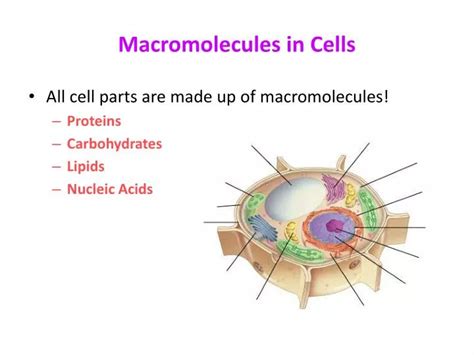Plant, fungal, bacterial, and algal cell walls are complex and dynamic structures composed of various macromolecules that contribute to their unique properties and functions. Understanding the composition and organization of these macromolecules is crucial for delving into the biology of these organisms and exploring potential applications in diverse fields.

Plant Cell Walls: A Matrix of Strength and Flexibility
Plant cell walls serve as the primary structural support for plant cells, providing rigidity and protection against mechanical stress. They are composed of a complex network of cellulose, hemicelluloses, and pectin, along with other minor components like lignin and proteins.
- Cellulose: The most abundant macromolecule in plant cell walls, cellulose is a linear polymer of glucose molecules arranged in parallel chains. These chains form crystalline structures that provide exceptional tensile strength and rigidity to the cell wall.
- Hemicelluloses: Hemicelluloses are a diverse group of branched polysaccharides, including xyloglucan, glucomannan, and arabinoxylan. They interact with cellulose microfibrils, forming a matrix that strengthens the cell wall and provides flexibility.
- Pectin: Pectin is a complex polysaccharide composed of galacturonic acid units. It forms a gel-like matrix that fills the spaces between cellulose and hemicellulose, contributing to cell wall elasticity and water retention.
Fungal Cell Walls: Defending Against Adversity
Fungal cell walls play a crucial role in protecting the fungus from external threats and maintaining its shape. They consist primarily of chitin and glucans, with varying amounts of other polysaccharides and proteins.
- Chitin: Chitin is a linear polymer of N-acetylglucosamine molecules, similar to cellulose in structure. It provides structural strength and rigidity to the fungal cell wall.
- Glucans: Glucans are polysaccharides composed of glucose molecules linked in different configurations. They form a network that reinforces the cell wall and protects against environmental stresses.
Bacterial Cell Walls: A Gram-Positive/Gram-Negative Divide
Bacterial cell walls exhibit significant diversity, dividing bacteria into two broad categories: Gram-positive and Gram-negative.
- Gram-Positive Bacteria: The cell walls of Gram-positive bacteria are thick and composed primarily of peptidoglycan, a complex polymer consisting of alternating units of N-acetylglucosamine and N-acetylmuramic acid. Peptidoglycan forms a rigid mesh-like structure that protects the bacterial cell from osmotic stress.
- Gram-Negative Bacteria: Gram-negative bacteria have a more complex cell wall structure. In addition to peptidoglycan, they possess an outer membrane composed of lipopolysaccharides (LPS) and lipoproteins. LPS molecules are amphipathic, meaning they have both hydrophilic and hydrophobic portions, contributing to the outer membrane’s impermeability and virulence.
Algal Cell Walls: Diversity in Function and Composition
Algal cell walls exhibit a wide range of compositions and functions, reflecting the diverse lifestyles of algae.
- Green Algae: The cell walls of green algae are primarily composed of cellulose, similar to plant cell walls. However, they may also contain other polysaccharides, such as mannan and xylan.
- Red Algae: Red algae have cell walls composed of cellulose and agarose, a sulfated polysaccharide that gives them a gelatinous texture and provides structural support.
- Brown Algae: Brown algae cell walls contain cellulose, alginic acid, and fucoidan, a sulfated polysaccharide that contributes to their flexibility and resistance to desiccation.
Macromolecular Interactions and Cell Wall Dynamics
The macromolecules in cell walls interact in complex and dynamic ways, influencing their overall properties and functions. These interactions include:
- Hydrogen Bonding: Hydrogen bonding between cellulose chains is responsible for the strength and rigidity of plant cell walls.
- Covalent Bonding: Peptidoglycan in bacterial cell walls is covalently cross-linked, contributing to its mesh-like structure and resistance to osmotic pressure.
- Ionic Bonding: Ionic interactions between charged polysaccharides and proteins in fungal cell walls stabilize their structure and regulate their interactions with the environment.
Common Mistakes to Avoid
When studying macromolecules involved in cell walls, avoid common errors such as:
- Equating Cellulose with Plant Cell Walls: While cellulose is a major component of plant cell walls, it is not the only one. Hemicelluloses and pectin are equally important in shaping cell wall properties.
- Oversimplifying Bacterial Cell Walls: Bacterial cell walls are not simply composed of peptidoglycan. Gram-negative bacteria possess an additional outer membrane with unique components like LPS.
- Assuming Algal Cell Walls are Identical: Algal cell walls vary significantly in composition and structure depending on the algal species and environmental conditions.
FAQs
-
What is the primary function of a cell wall?
– Cell walls provide structural support, protection, and shape maintenance for cells. -
Which macromolecule is most abundant in plant cell walls?
– Cellulose. -
What is the difference between Gram-positive and Gram-negative bacterial cell walls?
– Gram-positive bacteria have a thick peptidoglycan wall, while Gram-negative bacteria have a thin peptidoglycan wall and an outer membrane. -
What is the role of agarose in red algal cell walls?
– Agarose provides structural support and a gelatinous texture. -
How do macromolecular interactions influence cell wall properties?
– Hydrogen bonding, covalent bonding, and ionic interactions contribute to cell wall strength, stability, and elasticity. -
What are some potential applications of cell wall macromolecules?
– In biomaterials, drug delivery systems, and tissue engineering.
Conclusion
The macromolecules involved in cell walls play a vital role in the structural integrity, function, and adaptation of different organisms. Understanding their composition and interactions is crucial for advancing our knowledge of cell biology, biotechnology, and various other fields. By delving into the intricate workings of cell walls, we can uncover new insights and applications in diverse areas.
